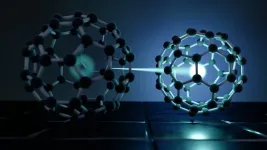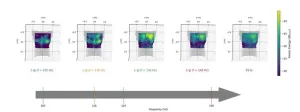(Press-News.org) From solar panels on our roofs to the new OLED TV screens, many everyday electronic devices simply wouldn’t work without the interaction between light and the materials that make up semiconductors. A new category of semiconductors is based on organic molecules, which largely consist of carbon, such as buckminsterfullerene. The way organic semiconductors work is largely determined by their behaviour in the first few moments after light excites electrons, forming “excitons” in the material. Researchers from the Universities of Göttingen, Graz, Kaiserslautern-Landau and Grenoble-Alpes have now, for the first time, made very fast and very precise images of these excitons – in fact, accurate to one quadrillionth of a second (0.000,000,000,000,001s) and one billionth of a metre (0.000,000,001m). This understanding is essential for developing more efficient materials with organic semiconductors. The results were published in Nature Communications.
When light hits a material, some electrons absorb the energy and this puts them into an excited state. In organic semiconductors, such as those used in OLEDs, the interaction between such excited electrons and left-over “holes” is very strong, and electrons and holes can no longer be described as individual particles. Instead, negatively charged electrons and positively charged holes combine to form pairs, known as excitons. Understanding the quantum mechanical properties of these excitons in organic semiconductors has long been considered a major challenge – both from a theoretical and an experimental point of view.
The new method sheds light on this puzzle. Wiebke Bennecke, physicist at the University of Göttingen and first author of the study, explains: "Using our photoemission electron microscope, we can recognise that the attractive forces within the excitons significantly change their energy and velocity distribution. We measure the changes with extremely high resolution in both time and space, and compare them with the theoretical predictions of quantum mechanics." The researchers refer to this new technique as photoemission exciton tomography. The theory behind it was developed by a team led by Professor Peter Puschnig at the University of Graz.
This new technique enables scientists, for the first time, to both measure and visualise the quantum mechanical wave function of the excitons. Put simply, the wave function describes the state of an exciton and determines its probability of being present. Dr Matthijs Jansen, Göttingen University, explains the significance of the findings: "The organic semiconductor that we studied was buckminsterfullerene which consists of a spherical arrangement of 60 carbon atoms. The question was whether an exciton would always be located on a single molecule or whether it could be distributed across several molecules simultaneously. This property can have a major influence on the efficiency of semiconductors in solar cells." Photoemission exciton tomography provides the answer: immediately after the exciton is generated by light, it is distributed over two or more molecules. However, within a few femtoseconds, meaning in a tiny fraction of a second, the exciton shrinks back down to a single molecule.
In future, the researchers want to record the behaviour of the excitons using the new method. According to Professor Stefan Mathias, Göttingen University, this holds potential: "For example, we want to see how the relative motion of molecules influences the dynamics of excitons in a material. These investigations will help us understand energy conversion processes in organic semiconductors. And we hope that this knowledge will contribute to the development of more efficient materials for solar cells."
This research benefited from the German Research Foundation (DFG) funding for the Collaborative Research Centres "Atomic scale control of energy conversion" and "Mathematics of Experiment" in Göttingen and "Spin+X" in Kaiserslautern-Landau. The team in Graz was supported by funding from the ERC Synergy Grant "Orbital Cinema" of the European Union.
Original publication: Bennecke, W. et al. Disentangling the multiorbital contributions of excitons by photoemission exciton tomography. Nature Communications (2024). DOI: 10.1038/s41467-024-45973-x
Contact:
Professor Stefan Mathias
University of Göttingen
Faculty of Physics
Friedrich Hund Platz 1, 37077 Göttingen, Germany
Tel: +49 (0)551 39-27601
Email: smathias@uni-goettingen.de
www.mathiaslab.uni-goettingen.de
Dr G S Matthijs Jansen
University of Göttingen
Faculty of Physics
Email: gsmjansen@uni-goettingen.de
Professor Peter Puschnig
University of Graz
Institute of Physics
University Square 5, 8010 Graz, Austria
Tel: +43 (316) 380 5230
Email: peter.puschnig@uni-graz.at
www.homepage.uni-graz.at/en/peter.puschnig
From solar panels on our roofs to the new OLED TV screens, many everyday electronic devices simply wouldn’t work without the interaction between light and the materials that make up semiconductors. A new category of semiconductors is based on organic molecules, which largely consist of carbon, such as buckminsterfullerene. The way organic semiconductors work is largely determined by their behaviour in the first few moments after light excites electrons, forming “excitons” in the material. Researchers from the Universities of Göttingen, Graz, Kaiserslautern-Landau and Grenoble-Alpes have now, for the first time, made very fast and very precise images of these excitons – in fact, accurate to one quadrillionth of a second (0.000,000,000,000,001s) and one billionth of a metre (0.000,000,001m). This understanding is essential for developing more efficient materials with organic semiconductors. The results were published in Nature Communications.
When light hits a material, some electrons absorb the energy and this puts them into an excited state. In organic semiconductors, such as those used in OLEDs, the interaction between such excited electrons and left-over “holes” is very strong, and electrons and holes can no longer be described as individual particles. Instead, negatively charged electrons and positively charged holes combine to form pairs, known as excitons. Understanding the quantum mechanical properties of these excitons in organic semiconductors has long been considered a major challenge – both from a theoretical and an experimental point of view.
The new method sheds light on this puzzle. Wiebke Bennecke, physicist at the University of Göttingen and first author of the study, explains: "Using our photoemission electron microscope, we can recognise that the attractive forces within the excitons significantly change their energy and velocity distribution. We measure the changes with extremely high resolution in both time and space, and compare them with the theoretical predictions of quantum mechanics." The researchers refer to this new technique as photoemission exciton tomography. The theory behind it was developed by a team led by Professor Peter Puschnig at the University of Graz.
This new technique enables scientists, for the first time, to both measure and visualise the quantum mechanical wave function of the excitons. Put simply, the wave function describes the state of an exciton and determines its probability of being present. Dr Matthijs Jansen, Göttingen University, explains the significance of the findings: "The organic semiconductor that we studied was buckminsterfullerene which consists of a spherical arrangement of 60 carbon atoms. The question was whether an exciton would always be located on a single molecule or whether it could be distributed across several molecules simultaneously. This property can have a major influence on the efficiency of semiconductors in solar cells." Photoemission exciton tomography provides the answer: immediately after the exciton is generated by light, it is distributed over two or more molecules. However, within a few femtoseconds, meaning in a tiny fraction of a second, the exciton shrinks back down to a single molecule.
In future, the researchers want to record the behaviour of the excitons using the new method. According to Professor Stefan Mathias, Göttingen University, this holds potential: "For example, we want to see how the relative motion of molecules influences the dynamics of excitons in a material. These investigations will help us understand energy conversion processes in organic semiconductors. And we hope that this knowledge will contribute to the development of more efficient materials for solar cells."
This research benefited from the German Research Foundation (DFG) funding for the Collaborative Research Centres "Atomic scale control of energy conversion" and "Mathematics of Experiment" in Göttingen and "Spin+X" in Kaiserslautern-Landau. The team in Graz was supported by funding from the ERC Synergy Grant "Orbital Cinema" of the European Union.
Original publication: Bennecke, W. et al. Disentangling the multiorbital contributions of excitons by photoemission exciton tomography. Nature Communications (2024). DOI: 10.1038/s41467-024-45973-x
Contact:
Professor Stefan Mathias
University of Göttingen
Faculty of Physics
Friedrich Hund Platz 1, 37077 Göttingen, Germany
Tel: +49 (0)551 39-27601
Email: smathias@uni-goettingen.de
www.mathiaslab.uni-goettingen.de
Dr G S Matthijs Jansen
University of Göttingen
Faculty of Physics
Email: gsmjansen@uni-goettingen.de
Professor Peter Puschnig
University of Graz
Institute of Physics
University Square 5, 8010 Graz, Austria
Tel: +43 (316) 380 5230
Email: peter.puschnig@uni-graz.at
www.homepage.uni-graz.at/en/peter.puschnig
END
Spectroscopy and theory shed light on excitons in semiconductors
Research team led by Göttingen University make extremely fast, precise images for first time
2024-03-19
ELSE PRESS RELEASES FROM THIS DATE:
Assessing the impact of malaria interventions through routine sampling of pregnant women
2024-03-19
Genetic diversity of the malaria parasite in pregnant women and children declined in an area targeted for malaria elimination in Mozambique, according to a study led by the Barcelona Institute for Global Health (ISGlobal), a centre supported by “la Caixa” Foundation and the Manhiça Health Research Centre (CISM). The findings, published in Nature Communications, highlight the added value of routine sampling of pregnant women as a cost-effective strategy to enhance genomic surveillance of the parasite and detect changes in transmission within the community.
Genomic surveillance of the malaria parasite P. falciparum is essential ...
Drug candidate may ‘unmask’ latent HIV-infected cells, mark them for destruction
2024-03-19
PITTSBURGH, March 19, 2024 – University of Pittsburgh School of Medicine scientists have identified drug candidates that show promise to reverse the ability of HIV to escape detection by the immune system.
The discovery, described today in Cell Chemical Biology, reveals a potential path to eliminate the viral reservoir that cannot be cleared with existing antiretroviral drugs. This reservoir is what prevents people from being completely cured of HIV even when their viral load is undetectable in standard tests.
“We ...
Epidemic of fatal prion disease kuru likely led to migration of women in the Eastern Highlands of Papua New Guinea
2024-03-19
In the most comprehensive genetic study of the people living in the Eastern Highlands of Papua New Guinea to date, researchers from Papua New Guinea and the U.K. revealed the complex population structure and migration patterns of the communities in the region. The results, published March 19 in The American Journal of Human Genetics, lay the foundation for future research on the fatal disease kuru—a disease transmitted during traditional anthropophagic mortuary practices— that devastated the area in the 20th century.
“We navigated one of the most complex landscapes possible in terms of geographical, cultural and linguistic diversity and set the scene ...
Biomarkers of the middle-aged brain predict cognitive health in old age
2024-03-19
The middle-aged brain could provide a window into future cognitive health, researchers write in a review publishing March 19 in the journal Trends in Neurosciences. The team reviewed evidence from human and animal studies suggesting that middle age—commonly considered as the period between 40 and 60 or 65 years of age—marks a shift in brain aging. They argue that more research should be dedicated to middle age, a period of life that is historically understudied.
“Middle age is associated with specific and modifiable risk factors for future dementia risk,” write the authors, who include neuroscientist Yvonne Nolan ...
USPSTF statement on primary care interventions to prevent child maltreatment
2024-03-19
Bottom Line: The U.S. Preventive Services Task Force (USPSTF) concludes that the current evidence is insufficient to assess the balance of benefits and harms of primary care interventions to prevent child maltreatment. Child maltreatment, which includes child abuse and neglect, can have profound effects on health, development, survival, and well-being throughout childhood and adulthood. The prevalence of child maltreatment in the U.S. is uncertain and likely underestimated. In 2021, an estimated 600,000 children were identified by Child Protective Services as experiencing abuse ...
Stroke risk after COVID-19 bivalent vaccination among US older adults
2024-03-19
About The Study: Among 11,000 Medicare beneficiaries age 65 or older who experienced stroke after receiving either brand of the COVID-19 bivalent vaccine, there was no evidence of a significantly elevated risk for stroke during the days immediately after vaccination.
Authors: Yun Lu, Ph.D., of the Food and Drug Administration in Silver Spring, Maryland, is the corresponding author.
To access the embargoed study: Visit our For The Media website at this link https://media.jamanetwork.com/
(doi:10.1001/jama.2024.1059)
Editor’s ...
New ultrasound technology may revolutionize respiratory disease diagnoses
2024-03-19
WASHINGTON, March 19, 2024 – The thorax, the part of the body between the neck and abdomen, provides medical professionals with a valuable window into a patient’s respiratory health. By evaluating sound vibrations produced by the airflow induced within the lungs and bronchial tree during normal breathing as well as those produced by the larynx during vocalizations, doctors can identify potential disease-related abnormalities within the respiratory system.
But, among other shortcomings, common respiratory assessments can be subjective and are only as good as the quality ...
Decision aid helps patients make informed decisions about sterilization
2024-03-19
Researchers at the University of Pittsburgh have developed a simple, web-based decision aid called My Decision/Mi Decisión that helps empower pregnant individuals who are considering tubal sterilization to make informed decisions about their reproductive health, according to a new study published today in JAMA Network Open.
With significant misunderstandings surrounding sterilization, the Pitt researchers can now offer comprehensive, engaging and accessible information to help support individuals as they make the best contraceptive decisions for themselves.
“When patients are making decisions about their health and fertility, we want to make certain ...
New spatial profiling approach maps out discoveries for future brain research
2024-03-19
An estimated one in six people suffer from a brain disorder worldwide, according to the American Brain Foundation. Current research has provided some insight into cell-communication inside the brain, but there are still a lot of unknowns surrounding how this crucial organ functions. What if there was a comprehensive map that took into consideration not just the biology of the brain, but the specific location where the biology occurs?
Researchers in the College of Engineering have developed a powerful, cost-effective method to do just that.
Chang Lu, the Fred W. Bull Professor of Chemical Engineering, has been leading ...
Family out-of-pocket expenditure on dental care
2024-03-19
Alexandria, VA, USA – A study aiming to determine if poorer families pay more for dental care as a proportion of their total income than richer families. was presented at the 102nd General Session of the IADR, which was held in conjunction with the 53rd Annual Meeting of the American Association for Dental, Oral, and Craniofacial Research and the 48th Annual Meeting of the Canadian Association for Dental Research, on March 13-16, 2024, in New Orleans, LA, USA.
The abstract, ...
LAST 30 PRESS RELEASES:
Decoupling the HOR enhancement on PtRu: Dynamically matching interfacial water to reaction coordinates
Sulfur isn’t poisonous when it synergistically acts with phosphine in olefins hydroformylation
URI researchers uncover molecular mechanisms behind speciation in corals
Chitin based carbon aerogel offers a cleaner way to store thermal energy
Tracing hidden sources of nitrate pollution in rapidly changing rural urban landscapes
Viruses on plastic pollution may quietly accelerate the spread of antibiotic resistance
Three UH Rainbow Babies & Children’s faculty elected to prestigious American Pediatric Society
Tunnel resilience models unveiled to aid post-earthquake recovery
Satellite communication systems: the future of 5G/6G connectivity
Space computing power networks: a new frontier for satellite technologies
Experiments advance potential of protein that makes hydrogen sulfide as a therapeutic target for Alzheimer’s disease
Examining private equity’s role in fertility care
Current Molecular Pharmacology achieves a landmark: real-time CiteScore advances to 7.2
Skeletal muscle epigenetic clocks developed using postmortem tissue from an Asian population
Estimating unemployment rates with social media data
Climate policies can backfire by eroding “green” values, study finds
Too much screen time too soon? A*STAR study links infant screen exposure to brain changes and teen anxiety
Global psychiatry mourns Professor Dan Stein, visionary who transformed mental health science across Africa and beyond
KIST develops eco-friendly palladium recovery technology to safeguard resource security
Statins significantly reduce mortality risk for adults with diabetes, regardless of cardiovascular risk
Brain immune cells may drive more damage in females than males with Alzheimer’s
Evidence-based recommendations empower clinicians to manage epilepsy in pregnancy
Fungus turns bark beetles’ defenses against them
There are new antivirals being tested for herpesviruses. Scientists now know how they work
CDI scientist, colleagues author review of global burden of fungus Candida auris
How does stroke influence speech comprehension?
B cells transiently unlock their plasticity, risking lymphoma development
Advanced AI dodel predicts spoken language outcomes in deaf children after cochlear implants
Multimodal imaging-based cerebral blood flow prediction model development in simulated microgravity
Accelerated streaming subgraph matching framework is faster, more robust, and scalable
[Press-News.org] Spectroscopy and theory shed light on excitons in semiconductorsResearch team led by Göttingen University make extremely fast, precise images for first time





